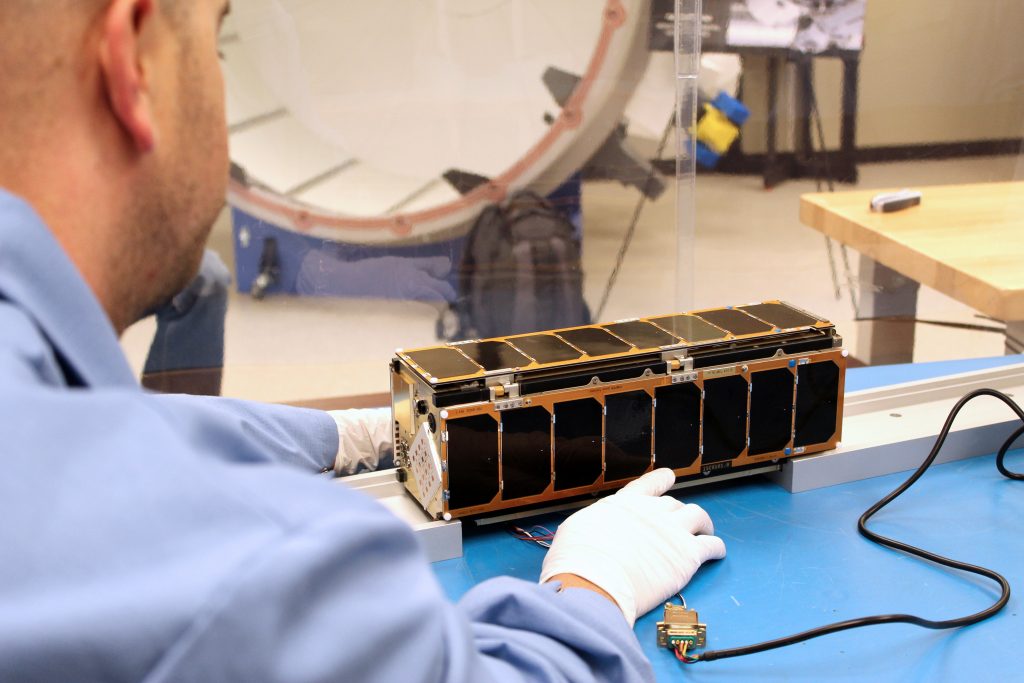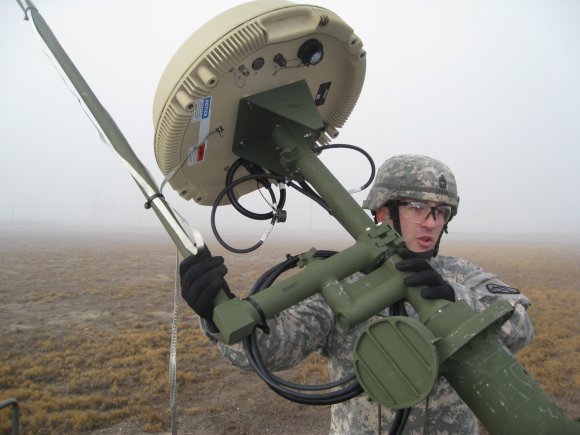Army, NASA Want Laser Micro-Satellites For 50 Times The Bandwidth
Posted on
ASSOCIATION OF THE US ARMY, ARLINGTON: War zones, it turns out, get crappy reception. But the Army, NASA, and multiple private companies are looking to optical communications — that means lasers — off affordable micro-satellites that could dramatically increase bandwidth. Just this morning, the federally funded Aerospace Corporation announced a successful test for NASA that provided bandwidth 50 times higher — an almost 5,000 percent increase — than current military satellites that use radio waves.
Bassett: Military Necessity
Not three hours before the Aerospace Co. announcement, Maj. Gen. David Bassett was getting excited about optical satellites at the Association of the US Army’s annual cyber and networks conference here. That matters because, after a successful tour in charge of armored vehicle programs, Bassett is now the Army’s Program Executive Officer for Command, Control, Communications – Tactical (PEO-C3T).
Currently, Bassett said, during a typical exercise at the Joint Readiness Training Center, meant to depict realistic combat conditions, an Army brigade HQ gets a satellite link that can transmit two megabits a second. By comparison, he said, one of his fellow panelists, Forcepoint Federal CTO George Kamis, had just clocked his smartphone at 70 megabits per second. That’s 35 times the power the 4,000-soldier brigade gets, for just one person.
“We have to provide more bandwidth to a headquarters than Mr. Kamis has in his pocket,” said Bassett.
But that’s not easy. War-torn countries generally don’t have a first-class network of cell towers and fiber optics. What they do have can get blown up at inconvenient times. So the Army has to bring its own communications infrastructure with it, one that works on the move and under fire. That system generally relies on glorified wifi networks on the ground — basically, radios plus computers — with long-range radio-frequency links provided by a small number of large, expensive satellites.
It was hard enough keeping the data flowing to the far mountains of Afghanistan, but at least the Taliban didn’t have the technology to attack the network. Russia and China, however, are investing heavily in capabilities to eavesdrop on or jam the radio transmissions and to blind or outright shoot down the satellites.
Laser beams don’t penetrate the atmosphere as easily as radio, but on the upside they’re much harder to jam. That’s because radio waves spread out over a wide area, so third parties can pick them up or send out a jamming signal to disrupt the original message. To stop a laser, however, you have to block the exact line of sight between sender and receiver, a much harder task.
What’s more, both the government and private sector have developed much smaller, less expensive satellites — often called “cubesats” after their simple, boxy shape — that can be launched in much larger numbers than traditional satellites. From a military perspective, a lot of cheap satellites is harder for the enemy to destroy in a future space war than a few expensive ones.
Aerospace Corp.: Technological Possibilities
Lots of companies — including Elon Musk’s SpaceX — are interested in laser-based (optical) communications, especially from one satellite to another, where there’s no air to get in the way. But NASA’s Optical Communications and Sensor Demonstration (OCSD) is shooting lasers through the atmosphere. The beams come down from a pair of cubesats in low earth orbit (AeroCube-7B and -7C), each of which weighs just five pounds.
That’s a dramatic contrast to the massive laser communications satellites the Pentagon once tried to develop under the T-SAT (Transformational Satellite) program. The apogee of the hubristic technophilia of so-called defense transformation, T-SAT was cancelled in 2010 after spending $1.5 billion. The bill for a full constellation of five satellites was an estimated $26 billion.
The OCSD cubesats are so small and simple, by contrast, that they don’t even have adjustable mirrors to aim their laser beams. Instead, the whole satellite rotates. It uses a sophisticated steering system — complete with tiny star trackers that takes bearings off the constellations — to aim itself within 1/40th of a degree of the intended target, in this case the Mount Wilson Observatory in California . (The best previous satellite had an accuracy of just one degree, Aerospace Corp. says, which is enough to miss the target at earth-to-orbit distances). They don’t even use rocket fuel to maneuver, instead carrying a small tank of water it sprays out as steam.
The space-to-ground link in this experiment clocked at 100 megabits per second. That’s 50 times the bandwidth of a conventional (i.e. radio) communications cubesat of the same size (2 megabits/second), Aerospace Corp. said. But NASA believes “relatively simple upgrades, primarily to the attitude control system, will enable download rates of 2.5 gigabits per second (Gb/s) or higher.” (For comparison, the entire T-SAT constellation was supposed to have a total worldwide capacity of 28.5 Gb/s.).
It’s important to note what the cubesats didn’t do. They didn’t communicate directly from one satellite to the other, although NASA is interested in testing that capability on a future mission, Aerospace Corp laser technology manager Todd Rose told me in an email. Nor did they test the uplink going the opposite direction, from a ground station to the satellites. That would require new hardware, both an appropriate ground terminal and a high efficiency receiver small enough to fit on the cubesat. But that should be doable, and the current experiment has provided valuable lessons on how to make it work.
“These are experiments that we would like to conduct in the future,” if NASA funds them, Rose told me. We’ll be watching developments closely — just not so closely the laser shines right in our eyes.
Subscribe to our newsletter
Promotions, new products and sales. Directly to your inbox.





